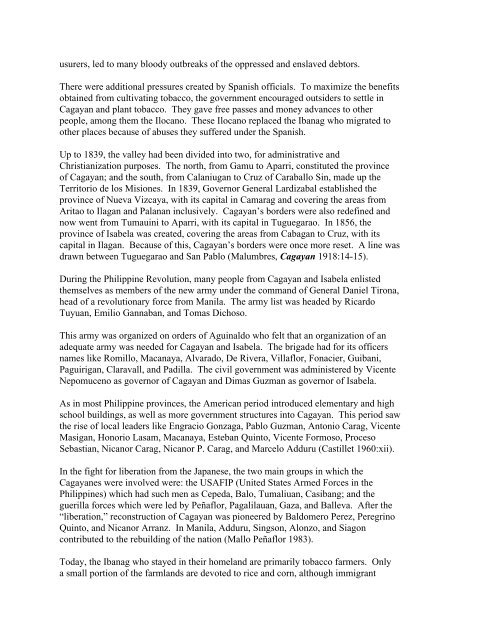The word “Ibanag” derives from the prefix “i” meaning ... - Buffalo
The word “Ibanag” derives from the prefix “i” meaning ... - Buffalo
The word “Ibanag” derives from the prefix “i” meaning ... - Buffalo
You also want an ePaper? Increase the reach of your titles
YUMPU automatically turns print PDFs into web optimized ePapers that Google loves.
usurers, led to many bloody outbreaks of <strong>the</strong> oppressed and enslaved debtors.<br />
<strong>The</strong>re were additional pressures created by Spanish officials. To maximize <strong>the</strong> benefits<br />
obtained <strong>from</strong> cultivating tobacco, <strong>the</strong> government encouraged outsiders to settle in<br />
Cagayan and plant tobacco. <strong>The</strong>y gave free passes and money advances to o<strong>the</strong>r<br />
people, among <strong>the</strong>m <strong>the</strong> Ilocano. <strong>The</strong>se Ilocano replaced <strong>the</strong> Ibanag who migrated to<br />
o<strong>the</strong>r places because of abuses <strong>the</strong>y suffered under <strong>the</strong> Spanish.<br />
Up to 1839, <strong>the</strong> valley had been divided into two, for administrative and<br />
Christianization purposes. <strong>The</strong> north, <strong>from</strong> Gamu to Aparri, constituted <strong>the</strong> province<br />
of Cagayan; and <strong>the</strong> south, <strong>from</strong> Calaniugan to Cruz of Caraballo Sin, made up <strong>the</strong><br />
Territorio de los Misiones. In 1839, Governor General Lardizabal established <strong>the</strong><br />
province of Nueva Vizcaya, with its capital in Camarag and covering <strong>the</strong> areas <strong>from</strong><br />
Aritao to Ilagan and Palanan inclusively. Cagayan’s borders were also redefined and<br />
now went <strong>from</strong> Tumauini to Aparri, with its capital in Tuguegarao. In 1856, <strong>the</strong><br />
province of Isabela was created, covering <strong>the</strong> areas <strong>from</strong> Cabagan to Cruz, with its<br />
capital in Ilagan. Because of this, Cagayan’s borders were once more reset. A line was<br />
drawn between Tuguegarao and San Pablo (Malumbres, Cagayan 1918:14-15).<br />
During <strong>the</strong> Philippine Revolution, many people <strong>from</strong> Cagayan and Isabela enlisted<br />
<strong>the</strong>mselves as members of <strong>the</strong> new army under <strong>the</strong> command of General Daniel Tirona,<br />
head of a revolutionary force <strong>from</strong> Manila. <strong>The</strong> army list was headed by Ricardo<br />
Tuyuan, Emilio Gannaban, and Tomas Dichoso.<br />
This army was organized on orders of Aguinaldo who felt that an organization of an<br />
adequate army was needed for Cagayan and Isabela. <strong>The</strong> brigade had for its officers<br />
names like Romillo, Macanaya, Alvarado, De Rivera, Villaflor, Fonacier, Guibani,<br />
Paguirigan, Claravall, and Padilla. <strong>The</strong> civil government was administered by Vicente<br />
Nepomuceno as governor of Cagayan and Dimas Guzman as governor of Isabela.<br />
As in most Philippine provinces, <strong>the</strong> American period introduced elementary and high<br />
school buildings, as well as more government structures into Cagayan. This period saw<br />
<strong>the</strong> rise of local leaders like Engracio Gonzaga, Pablo Guzman, Antonio Carag, Vicente<br />
Masigan, Honorio Lasam, Macanaya, Esteban Quinto, Vicente Formoso, Proceso<br />
Sebastian, Nicanor Carag, Nicanor P. Carag, and Marcelo Adduru (Castillet 1960:xii).<br />
In <strong>the</strong> fight for liberation <strong>from</strong> <strong>the</strong> Japanese, <strong>the</strong> two main groups in which <strong>the</strong><br />
Cagayanes were involved were: <strong>the</strong> USAFIP (United States Armed Forces in <strong>the</strong><br />
Philippines) which had such men as Cepeda, Balo, Tumaliuan, Casibang; and <strong>the</strong><br />
guerilla forces which were led by Peñaflor, Pagalilauan, Gaza, and Balleva. After <strong>the</strong><br />
“liberation,” reconstruction of Cagayan was pioneered by Baldomero Perez, Peregrino<br />
Quinto, and Nicanor Arranz. In Manila, Adduru, Singson, Alonzo, and Siagon<br />
contributed to <strong>the</strong> rebuilding of <strong>the</strong> nation (Mallo Peñaflor 1983).<br />
Today, <strong>the</strong> Ibanag who stayed in <strong>the</strong>ir homeland are primarily tobacco farmers. Only<br />
a small portion of <strong>the</strong> farmlands are devoted to rice and corn, although immigrant
















